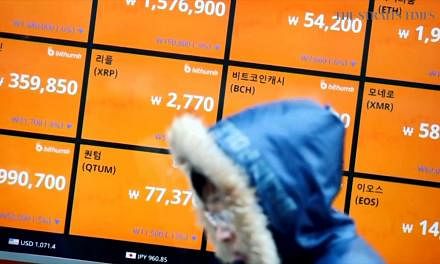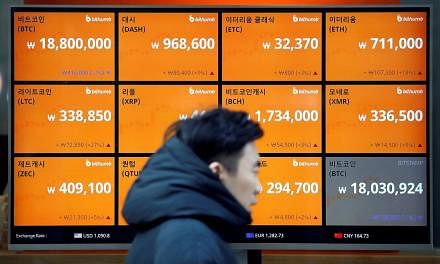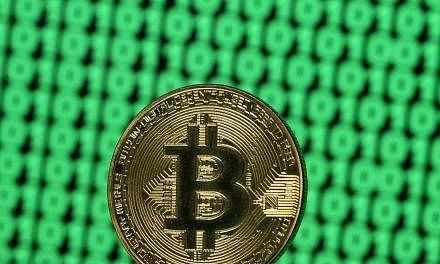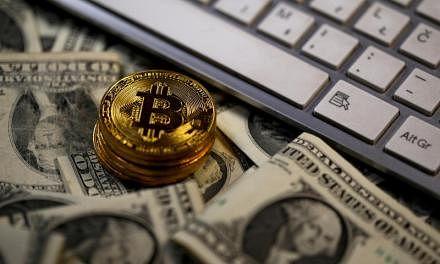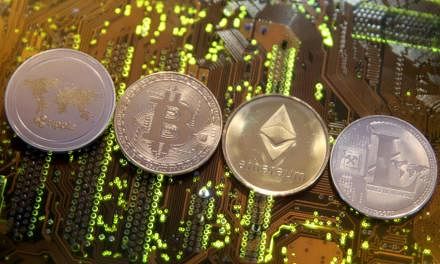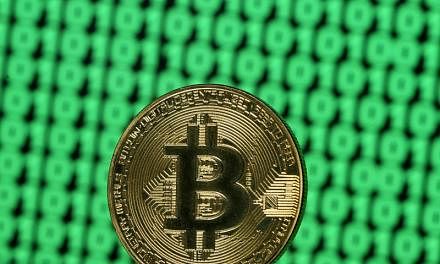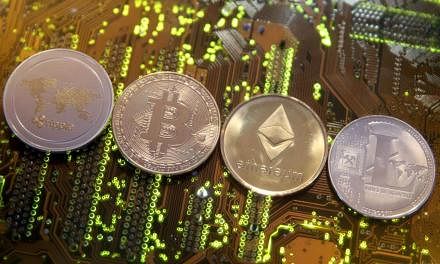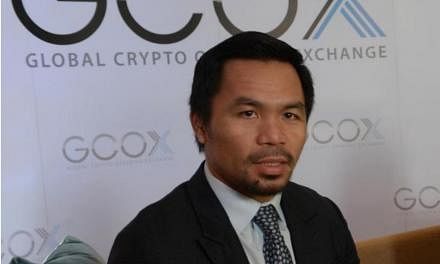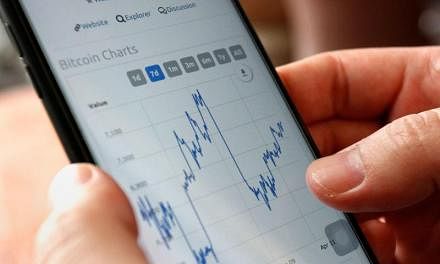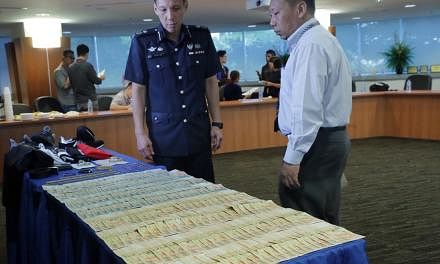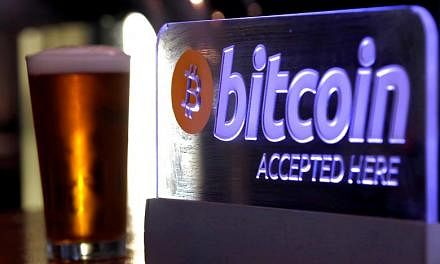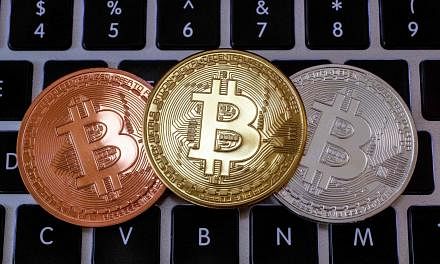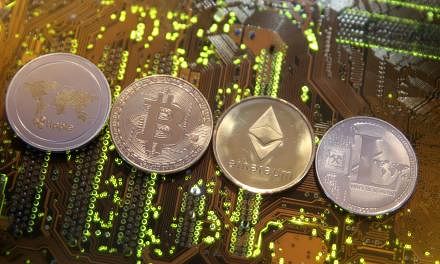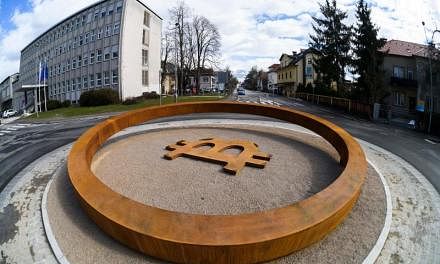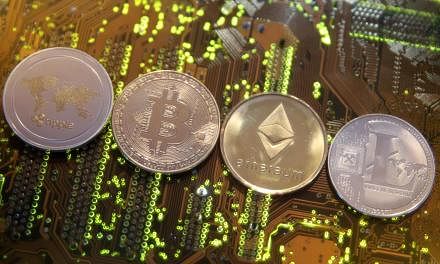It can eradicate world poverty. It can save the rainforest. It can protect us from Big Brother.
Such are the magical properties admirers bestow on blockchain, the technology underlying bitcoin, which is its first application.
The revolutionary promise of blockchain, which is touted as the harbinger of the fourth Industrial Revolution, has created a gold-rush mentality, reminiscent of the early days of the Internet. The hype and the Fomo (fear of missing out) factor have led hundreds of companies to unveil so-called blockchain initiatives. Venture capitalists have poured more than US$2 billion (S$2.6 billion) into blockchain ventures, most of it over just the last two years.
Seeking fortune by association, companies in fields as varied as iced tea, fruit juice, furniture, traditional Chinese tea, sports bras and e-cigarettes have rebranded themselves as blockchain companies, and some have witnessed huge run-ups in their share prices as a result. It is not unlike in the early 1990s, when companies were able to reap windfall gains in market capitalisation merely by adding the prefix "E" or the suffix "dot.com" to their names.
Don't get me wrong. Blockchain is a big deal and its distributed ledger technology has the potential to be transformative. Let us look at some of the advantages.
While the Internet revolutionised the direct person-to-person sharing of data, such as e-mail and voice and instant messaging, the one thing it cannot enable efficiently or safely is the sharing of value. The Internet can't solve the "double-spend" problem: You can send the same digital image to two people online, but you should not be able to send the same $5 to two people. If you did, money would lose its scarcity and hence its value.
So, if you want to send money or anything else valuable over the Internet, you have to go through an intermediary to manage and verify the transaction, such as a bank or a money transfer service like Western Union, or a broker, all of whom deduct fat fees as commissions. These intermediaries act as institutions of trust, verifying that your money has been sent to another person, deducting it from your account and crediting it to the receiver's.
With blockchain, peer-to-peer transactions are possible with no intermediary. For example, you can send bitcoin - a virtual currency that uses blockchain - to anybody without a bank being involved and (at least in theory) pay tiny commissions. Blockchain solves the risk of double-spending by lodging every transaction on a time-stamped universal ledger automatically, without the need for an intermediary. By removing the need for an intermediary to verify transactions, blockchain opens up many services and exchanges to people at very low to zero cost.

The implications are said to be potentially game-changing across a staggering range of industries and activities.
Land titles can be put on the blockchain, which means they can never be altered or challenged, which would enable hundreds of millions of the world's poor to have secure property rights - though enforcement is another matter.
People who generate their own electricity (through, for example, solar panels) can sell it peer-to-peer, without utilities coming in the way.
Commuters can connect with drivers directly on a blockchain without using intermediaries like Uber or Grab.
Stock transactions can be settled within seconds, securely and verifiably, without the need for brokers or cumbersome clearing and settlement systems.
Valuables such as diamonds can be tracked - individual diamonds can be given unique identities which are put on the blockchain. They can then be monitored as they are sold and resold, which prevents fraud or theft. A company called Everledger is already doing this, and extending its service to other valuable items such as jewellery, fine art, watches and other luxury goods.
There are countless other examples of how blockchain can, at least in theory, cut transaction costs, improve efficiencies and reduce fraud.
The blockchain also enables "smart contracts" which are self-executing and secured by digital code.
For example, if two parties agree to the terms of a contract - say, that a payment will be made when a certain item is delivered - the payment is automatically triggered the moment delivery takes place. The contract, which defines rules, obligations and penalties, is on the blockchain, time-stamped and cannot be altered, as if it were cast in stone.
And so, blockchain evangelists tout it as "The Trust Protocol", suggesting that it eliminates the need for trust; strangers can easily transact with each other with no third parties.
BEYOND THE HYPE
While all of this sounds exciting, it masks a lot of hype.
Take the key issue of trust. While it is true that you can, for example, send cryptocurrency to someone on the other side of the world quickly at low cost without a bank or a traditional money transfer service, this does not mean the problem of trust has been eliminated. It has simply been shifted to somewhere else.
To convert your dollars into bitcoin or any other crypto, you need to go through a cryptocurrency exchange or some other third party. These exchanges can be, and have been, hacked, including the one-time granddaddy of them all, Mt Gox. Your cryptocurrency wallet, which resides in your phone, can also be hacked. Would you trust an unregulated crypto exchange more than you trust your bank?
You also have to trust the blockchain-mining network, through which transactions are verified and cryptocurrencies generated. In theory, the blockchain is decentralised on millions of computers spread across the world, which makes it safe from Big Brother centralised control - which was claimed to be one of its big advantages.
In reality, however, most miners are merged into "pools" or cartels so they can enjoy economies of scale in computing power, and share income. About 80 per cent of the pools are in one country - China. The top four mining pools in the world control more than half of all computing power. This makes blockchain much less safe from manipulation than a truly decentralised mining network.
Nor are transactors in the blockchain anonymous. Rather, they are pseudonymous, identified by electronic addresses. Once somebody makes the link between your pseudonym and you - which can happen when you send money to somebody over the blockchain - your entire transaction activity, past and future, can be known. Such financial transparency is not what many individuals or companies would want.
Any data entered into a blockchain is also subject to human error. In the end, you do have to trust humans.
BLOCKCHAIN IS MISUSED
There are also signs that blockchain technology is being adopted for its own sake, even though it does not solve the problem it purports to solve. In other words, it is being misused.
Take the case of Kodak, which on Jan 31, will launch a scheme that will supposedly make life easier for the world's photographers. In partnership with a company called Wenn Digital, it will create a "photo-centric cryptocurrency" on the blockchain which it claims will "empower photographers and agencies to take greater control in image rights management".
It is an intriguing idea. Currently, you can download and use thousands of photos off the Internet that have no ownership rights. So the photographers who took those photos do not get compensated.
Kodak's new system, called the KodakOne blockchain, will create an immutable digital ledger for rights ownership for photographers. They upload their photos to the system, and are given the rights to license them.
So every photo can be tracked and if somebody uses a photo, the photographer gets paid instantly. KodakOne will also trawl the Internet 24/7 to identify any unlicensed use of the images and then, according to its press release, "manage the post-licensing process" in order to reward photographers - although it does not specify how.
This apparently ingenious scheme would cut out middlemen like Getty Images and Shutterstock, through which photographers currently sell their work but end up losing 30 per cent or more in commissions.
But here is the catch: People can't use normal money to pay for the photographs. They will need to use KodakCoin - a new cryptocurrency that Kodak will launch in an ICO on Jan 31. (In an ICO, or initial coin offering, someone offers investors units of a new cryptocurrency or crypto-token in exchange for a service or product.) And who can buy KodakCoin? Only "accredited investors", defined as people who have at least US$200,000 in income or a net worth of US$1 million, which excludes most people.
The photographers will also be paid in KodakCoin (although Kodak will, of course, take a commission). They will be able to spend it on other (as yet unknown) items that can be bought by KodakCoin. How they will convert it into real money is not clear.
Here is a classic example of the misuse of the blockchain. It is not the solution to the problem of matching buyers to sellers of photographs. An ICO is not needed to do this. The whole scheme looks suspiciously like Kodak just wanted to jump on the blockchain bandwagon. Its long-beleaguered stock price jumped 44 per cent on the day of its announcement, which means investors bought into the hype, just as they did in the early Internet days.
Blockchain technology holds out promise, but it is far from flawless. It is clunky, geeky and user-unfriendly. Environmentally, it is a disaster. Just one application - bitcoin - consumes more electricity than all of Ireland. Imagine what a thousand applications would do.
Maybe it will evolve to be useful, practical and environmentally friendly. But we are still a long way from witnessing its true benefits. What we are witnessing now is mostly hype.

